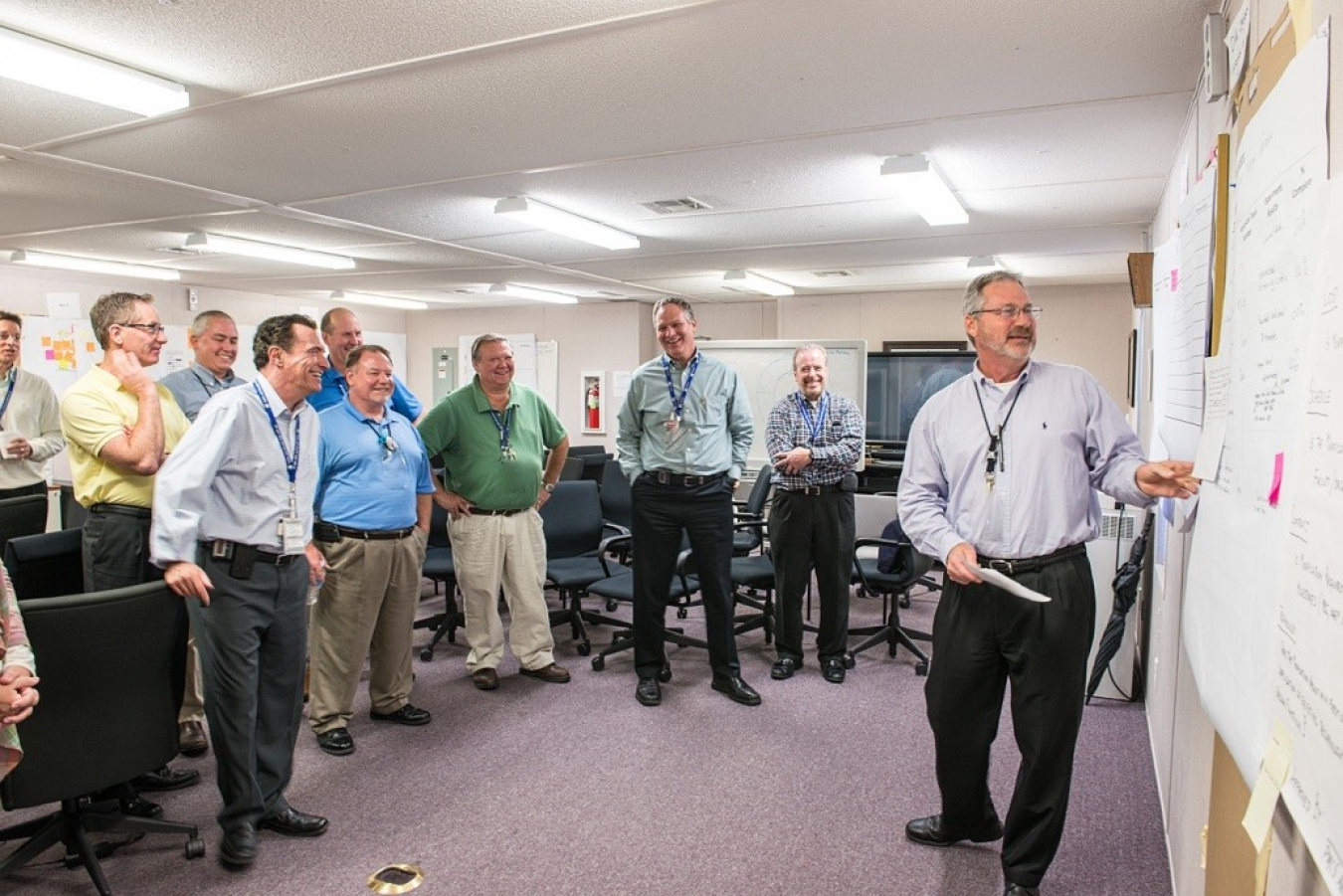E-flares, shown in the circle, are used in HB Line areas to help alert personnel of radioactivity levels and personal protective equipment requirements.

At right, Ken Brooks, SRNS projects manager, leads a project management improvement session.
AIKEN, S.C. – EM and the management and operations contractor at the Savannah River Site (SRS) have achieved millions of dollars in savings through two major cost-cutting efforts.
EM will save more than $1.7 million annually using a new radiation protection approach that further improves safety and efficiency at the chemical processing facility known as HB Line. Contractor Savannah River Nuclear Solutions (SRNS) streamlined its work, producing an estimated savings of nearly $2.7 million through the end of its contract in 2018.
Under the new HB Line approach, areas requiring respiratory protection and other personal protective equipment (PPE) in the facility now have requirements more tailored to conditions involving airborne radioactivity. The cost savings come from reductions in labor and laundry costs, required respirator usage and air sampling analysis costs.
HB Line process rooms had radiological postings of airborne radioactivity areas (ARAs), requiring respiratory protection and other PPE for a contamination area (CA). However, as the potential for airborne radioactivity was small, the decision to post these areas as ARAs was made out of an abundance of caution.
“Any intrusive work (work in a glovebox) still requires respiratory protection, so the areas are posted as airborne radioactivity areas during that time,” HB Line Radiological Protection Department (RPD) Deputy Facility Manager Jim Wood said. “Once intrusive work is completed, and the area goes back to normal surveillance and operations, the room gets posted as a contamination area again.”
To ensure no airborne contamination after intrusive work, radiation protection personnel installed continuous air monitors that sound an alarm for airborne radioactivity. This protection is in addition to routine surveys.
“We also took extra precautions to prevent personnel from entering one of these areas with the wrong PPE,” HB Line RPD Facility Manager Johnny Lott said. “We installed E-flares to help notify personnel when a room is posted as an ARA. A solid red light indicates that the room is currently an ARA and requires respiratory protection to enter. Once the continuous air monitors confirm that the air is clear and all surveys have been completed, the e-flare is then removed from the door, indicating the room has changed to a CA. These flares are in addition to regular radiological postings.”
Eliminating respiratory protection is a cost savings and benefit to safety. Potential heat stress from wearing this protection has greatly decreased. It’s easier to see and move with reduced PPE, making it safer for operators doing rounds.
“Personnel exhibited a great questioning attitude to ask how they could improve processes and used their experience and knowledge to make it happen,” said Wyatt Clark, SRNS senior vice president, EM operations. “I truly appreciate the tremendous amount of work and time that our radiological protection personnel put in to make our processes, safer, more efficient and more cost conscious.”
In another cost-cutting effort, the estimated $2.7 million in savings result from an ongoing project management value stream analysis (VSA). A team of subject-matter experts from inside and outside SRNS are identifying opportunities for improvements and a path for implementing them. The team has so far convened more than a dozen multi-day sessions.
“The SRNS culture puts a priority on continuous improvement,” said SRNS President and CEO Stuart MacVean. “We encourage our employees at all levels to always be thinking about how we can do our job better, more safely and more efficiently. This project management effort is a great example of that.”
The analysis led to improvements to SRNS project management processes that reduce duplicative or unnecessary paperwork and other time-consuming steps. SRNS streamlined the upfront screening process for new facility modifications to better determine project management controls and oversight needed to mitigate business risk. This improvement is projected to result in potential savings of over $1.8 million through 2018.
The analysis resulted in a reduction in the average project closure time from over 1,000 days to 180 days, aligning with DOE’s financial guidelines. SRNS also consolidated critical decision packages, which are high-level decision gates required by DOE for large projects to advance. Combining the packages where appropriate significantly reduces external reviews and associated cost and schedule impacts.
“Project management is a multifaceted process, affecting groups from engineering, construction and project controls to finance and risk management,” said Ken Brooks, manager of projects. “When we embarked on this VSA journey, our team recognized an overall lack of standard work for elements of the project management processes. Some procedures were cumbersome and inefficient, and the project closeout process durations were significantly higher than our customer’s expectations.”
The analysis is part of the SRNS Focused Improvement Transformation and IDEAS (Individuals Developing Effective Alternative Solutions) programs, which look to improve products, services and processes. Employees can submit suggestions for improvements and increased safety through the IDEAS program.
“The Focused Improvement Transformation is all about people, and allowing people to work as teams to improve their processes and identify and eliminate waste and non-value added work from their processes. It’s a win-win,” said P. K. Hightower, manager of SRNS continuous improvement.
